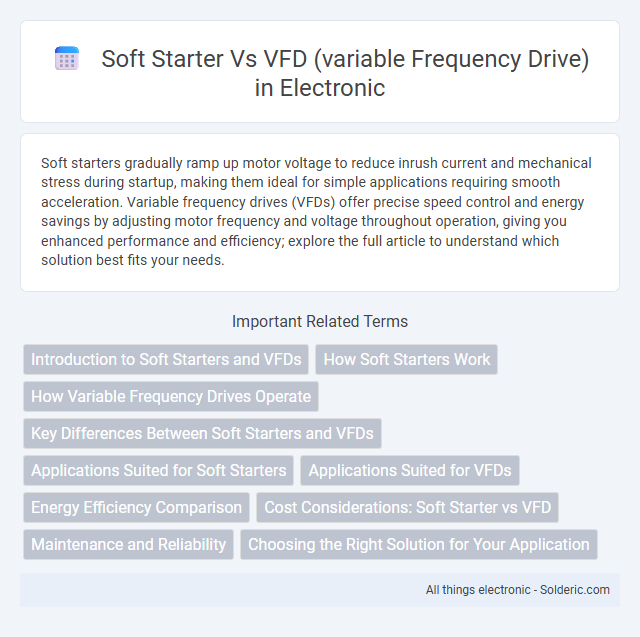Soft starters gradually ramp up motor voltage to reduce inrush current and mechanical stress during startup, making them ideal for simple applications requiring smooth acceleration. Variable frequency drives (VFDs) offer precise speed control and energy savings by adjusting motor frequency and voltage throughout operation, giving you enhanced performance and efficiency; explore the full article to understand which solution best fits your needs.
Comparison Table
| Feature | Soft Starter | Variable Frequency Drive (VFD) |
|---|---|---|
| Primary Function | Controls motor starting current by gradually increasing voltage | Controls motor speed and torque by varying frequency and voltage |
| Speed Control | No speed control; motor runs at full speed after start | Full speed control from zero to maximum speed |
| Energy Efficiency | Limited energy savings during start | Significant energy savings during operation at reduced speed |
| Application | Simple start/stop applications and torque-limited starts | Complex process control requiring speed and torque variation |
| Cost | Lower initial cost | Higher initial cost |
| Motor Protection | Protects against high inrush current and mechanical stress | Provides advanced protection including overload, stall, and thermal |
| Maintenance | Lower maintenance due to simpler design | Requires more maintenance due to complex electronics |
| Installation Complexity | Simple installation | More complex installation and programming |
Introduction to Soft Starters and VFDs
Soft starters and variable frequency drives (VFDs) are essential devices for controlling electric motor startup and speed. Soft starters limit the inrush current during motor startup by gradually increasing voltage, reducing mechanical stress and electrical demand. VFDs offer advanced motor control by adjusting both voltage and frequency, allowing precise speed regulation and energy savings in your applications.
How Soft Starters Work
Soft starters work by gradually ramping up the voltage supplied to the motor during startup, reducing inrush current and minimizing mechanical stress on your equipment. They use solid-state devices, such as thyristors, to control the initial voltage and smoothly increase it until the motor reaches full speed. This method provides a cost-effective solution for applications requiring controlled acceleration without the complexity of speed variation offered by VFDs.
How Variable Frequency Drives Operate
Variable Frequency Drives (VFDs) operate by adjusting the frequency and voltage supplied to an electric motor, allowing precise control of motor speed and torque. Unlike soft starters that only manage the initial inrush current during start-up, VFDs provide continuous control throughout the motor's operation, enhancing energy efficiency and process performance. Your system benefits from reduced mechanical stress and optimized power consumption when using VFD technology.
Key Differences Between Soft Starters and VFDs
Soft starters limit the inrush current and reduce mechanical stress during motor startup by gradually increasing voltage, while VFDs control motor speed and torque by varying frequency and voltage throughout operation. Soft starters are typically simpler and more cost-effective for basic starting needs, whereas VFDs offer advanced energy savings, precise speed control, and improved process efficiency. Your choice depends on whether you need just smooth starting or full motor speed control and optimization.
Applications Suited for Soft Starters
Soft starters are ideal for applications requiring reduced inrush current and smooth motor startup, such as conveyors, pumps, and fans where precise speed control is unnecessary. They are well-suited for minimizing mechanical stress and electrical surges during motor acceleration in industries like water treatment, HVAC, and material handling. Your choice of a soft starter benefits equipment longevity and energy efficiency in systems with straightforward starting demands.
Applications Suited for VFDs
VFDs (Variable Frequency Drives) excel in applications requiring precise motor speed control, energy efficiency, and load adaptability, such as HVAC systems, conveyor belts, and pumps. They are ideal for processes with varying torque demands and frequent start-stop cycles, offering improved performance and reduced mechanical stress. Your systems benefit from VFDs when optimizing operational costs and enhancing process control flexibility.
Energy Efficiency Comparison
Soft starters reduce inrush current and mechanical stress during motor startup but operate at full line voltage once running, leading to limited energy savings. Variable Frequency Drives (VFDs) adjust motor speed by varying voltage and frequency, enabling precise control and significant energy reductions, especially in variable load applications. Studies show VFDs can improve energy efficiency by up to 50% compared to soft starters in processes involving speed variation.
Cost Considerations: Soft Starter vs VFD
Soft starters generally offer lower upfront costs compared to Variable Frequency Drives (VFDs), making them a cost-effective option for applications requiring reduced starting current without variable speed control. VFDs entail higher initial investment due to advanced technology and provide energy savings over time by enabling precise motor speed regulation, reducing operational costs in variable load environments. Maintenance expenses for soft starters are typically lower, but the long-term operational efficiency and flexibility of VFDs often justify their higher acquisition cost in demanding industrial applications.
Maintenance and Reliability
Soft starters require less frequent maintenance due to fewer moving parts and simpler design, leading to increased reliability in straightforward motor applications. Variable frequency drives (VFDs) offer advanced control and energy savings but may demand more regular maintenance, including cooling system checks and firmware updates, to ensure long-term reliability. Your choice depends on the specific application requirements and the balance between maintenance capabilities and operational flexibility.
Choosing the Right Solution for Your Application
Soft starters provide smooth motor startup by gradually ramping up voltage, ideal for applications requiring reduced inrush current without speed control. Variable frequency drives (VFDs) offer precise motor speed and torque control, enhancing energy efficiency and process flexibility in dynamic operations. Selecting between a soft starter and VFD depends on specific application needs such as load characteristics, control complexity, and energy savings priorities.
soft starter vs VFD (variable frequency drive) Infographic

 solderic.com
solderic.com